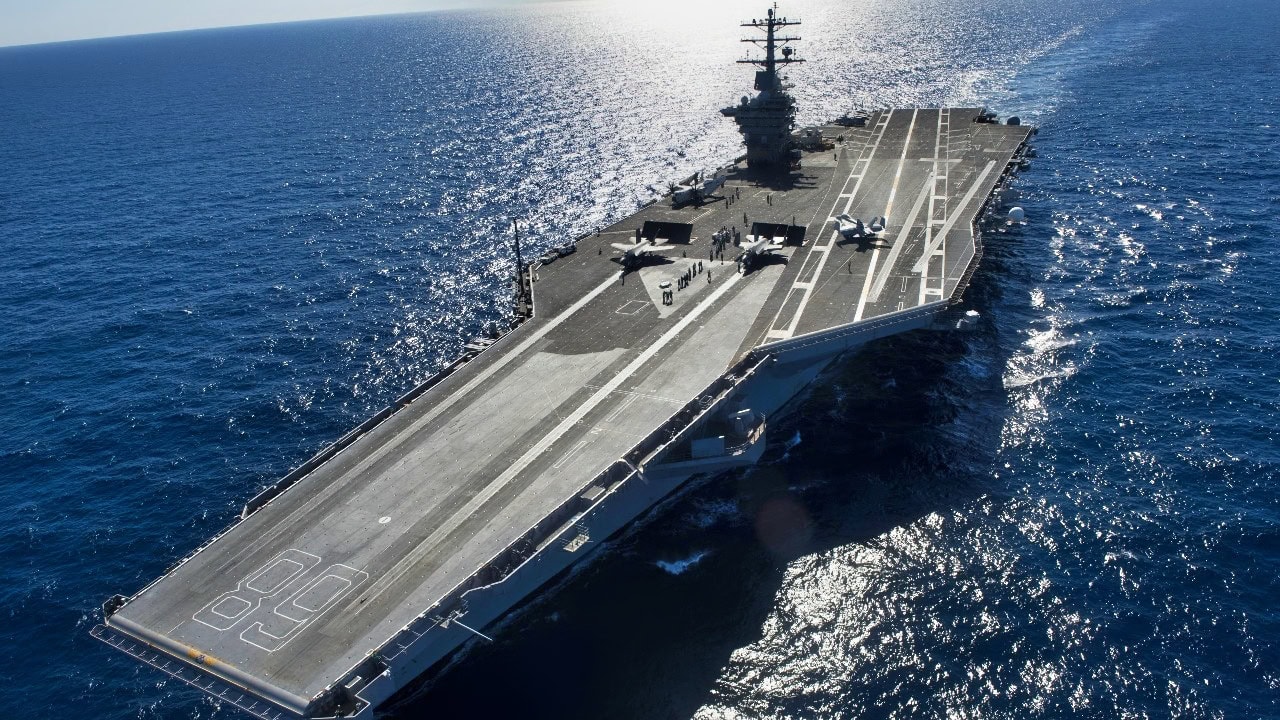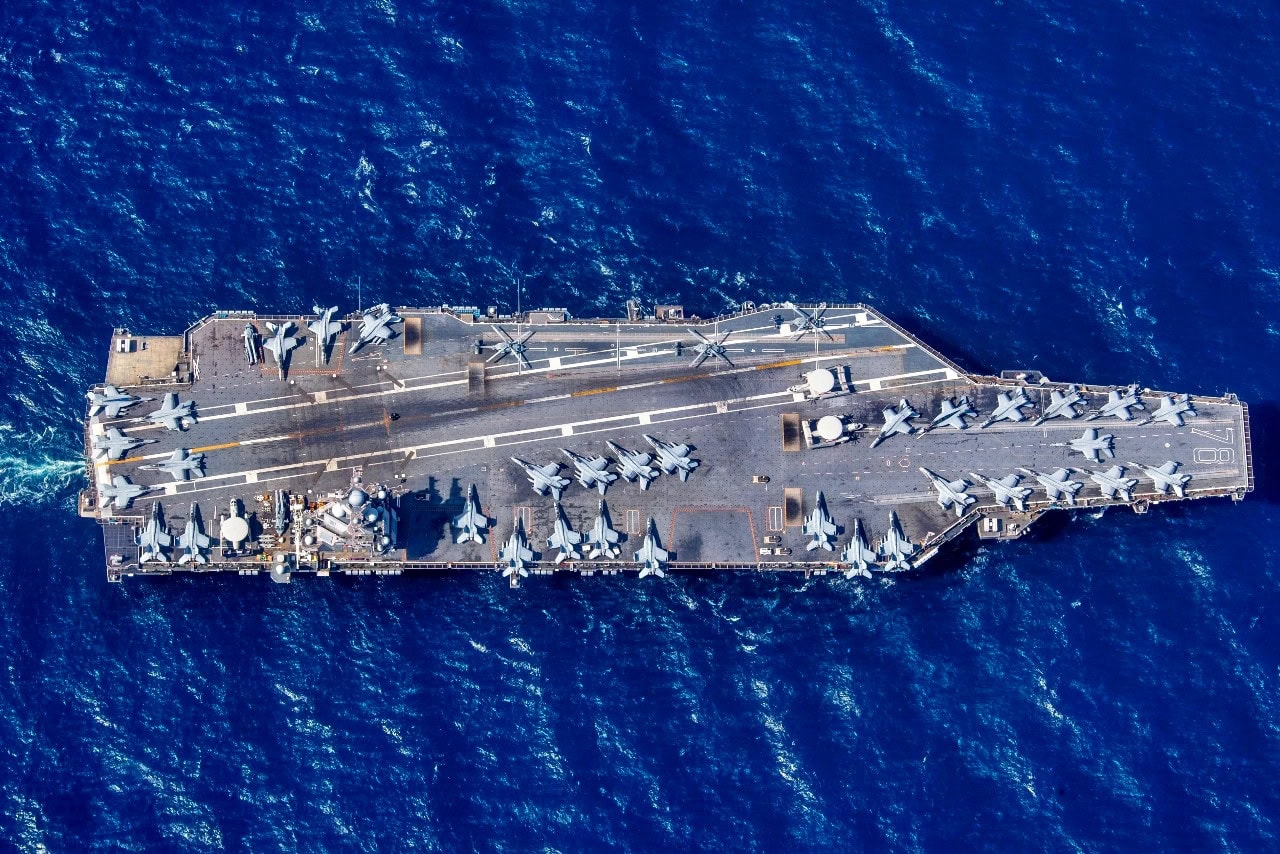Key Points and Summary – The Ford-class aircraft carriers sit at the center of a bitter debate about the future of U.S. sea power.
-Critics cite $13 billion price tags, balky new tech, long maintenance cycles, and China’s growing arsenal of carrier-killer missiles and drones as reasons to cancel follow-on Fords and invest instead in subs, destroyers, and the F/A-XX.

The aircraft carrier USS Gerald R. Ford (CVN 78) successfully completes the third and final scheduled explosive event of Full Ship Shock Trials while underway in the Atlantic Ocean, Aug. 8, 2021. The U.S. Navy conducts shock trials of new ship designs using live explosives to confirm that our warships can continue to meet demanding mission requirements under harsh conditions they might encounter in battle. (U.S. Navy photo by Mass Communication Specialist 3rd Class Novalee Manzella)

Ford-Class. Image Credit: Creative Commons.
-Yet China’s own carrier buildup, the need to deter both Beijing and Moscow, and the limits of land bases argue the opposite.
-The piece concludes that, despite costs and vulnerabilities, ending the Ford program would dangerously undercut U.S. global reach and deterrence.
Should the U.S. Navy Cancel the Ford-class Aircraft Carrier Program?
We assume that U.S. aircraft carriers will always be stalwart in defending American national interests. No ship can match the carrier for national prestige and for carrying the flag to keep navigation open around the world’s oceans.
They maintain sea lines of communication and guarantee freedom of trade and commerce worldwide.
But carriers are deathly expensive to build. They spend long times in port for maintenance and refueling.
They are costly to keep in the water. American flat-tops could also be eliminated by Chinese carrier-killer missiles, loitering kamikaze drones, enemy warplanes, or submarines. The days of the carrier’s overwhelming dominance may be over.
Stop the Expensive Construction of the Ford-class
For these reasons, the U.S. Navy could even cancel the Gerald R. Ford-class of carriers. The Ford is now patrolling the Caribbean, spoiling for a fight with Venezuela.
The aircraft’s wings deliver unmatched firepower to secure dominance in the Western Hemisphere.

(April 8, 2017) — Logistics Specialist 3rd Class Miguel Monduy, from Miami, Florida, and Aviation Ordnanceman Airman Michael Valdez, from Pheonix, Arizona, assigned to Pre-Commissioning Unit Gerald R. Ford (CVN 78), stand on the flight deck for shifting colors. The future USS Gerald R. Ford (CVN 78) is underway on its own power for the first time. The first-of-class ship — the first new U.S. aircraft carrier design in 40 years — will spend several days conducting builder’s sea trials, a comprehensive test of many of the ship’s key systems and technologies. (U.S. Navy photo by Mass Communication Specialist Seaman Gitte Schirrmacher)
The Ford-class USS John F. Kennedy will be delayed by 2 years, meaning the Navy will go a full 12 months with only 10 carriers, and not all of them will be on active duty.
The Kennedy is suffering from problems with Advanced Arresting Gear and Advanced Weapons Elevator – two issues that plagued the Ford as well and resulted in cost overruns and schedule slips for that carrier.
Re-invest the Money Saved Into Other Programs
The money saved from cancelling the John F. Kennedy could go to building other destroyers and cruisers.
The funds could be plowed into buying more submarines, such as the Virginia-class Block V. The sixth-generation F/A-XX fighter would receive full funding, as would the DDG(X) next-generation guided-missile destroyer.
But Ford-class cancellation is problematic. The Navy still needs all the carriers it can get in the water. China has three of its own and a fourth on the way that could be nuclear-powered. The Chinese navy aims to have six carriers by 2030. A world without new U.S. flat-tops would be dangerous and uncertain. The Navy enjoys strategic clarity with its carriers. This allows the United States to serve as a policeman in hot spots that require U.S. leadership.
Instruments of Old Wars Not New Conflicts
What if carriers are obsolete, though?
China already has a strategy of anti-access/ area denial that keeps the United States down and out in East Asia. U.S. flat-tops must stay out of range of the dangerous anti-ship missiles. The days of sending two aircraft carriers to the Taiwan Strait as President Bill Clinton once ordered in 1996 are gone. China can forge a defensive bubble around Taiwan and create a blockade of the island to starve Taipei, and then an amphibious operation could follow. Some Chinese generals and admirals believe they could depose the Taiwanese government in 100 hours with few casualties.

Depiction of Chinese missiles attacking the U.S. Navy. Image: Chinese Internet.

Military vehicles carrying DF-21D ballistic missiles roll to Tiananmen Square during a military parade to mark the 70th anniversary of the end of World War Two, in Beijing, China, September 3, 2015. REUTERS/Damir Sagolj
China also features the “Assassin’s Mace” type of weapon. This strategy is to use asymmetric warfare tools against U.S. carriers, such as ballistic missiles and cheaply-made drones.
There are about 10 different unmanned systems that China deploys – some for reconnaissance, others for surface strike. Chinese anti-ship cruise missiles and torpedoes from submarines are also a worry.
South Korea, Okinawa, and Guam Are In Danger
The East and South China Seas are becoming lakes for China as it uses carriers to dominate the First and Second Island Chains to place U.S. installations in South Korea, Guam, and Okinawa in danger of attacks. Chinese carriers could send fighter jets to blow up runways on U.S. air bases to keep F-22s and F-35s from taking to the air to meet challenges in the air.
Without U.S. aircraft carriers to put up a fight, China could dominate the region in the critical early phase of warfare, leaving the Americans under siege. Plus, other Assassin’s Mace tools would be used by the Chinese, such as cyber attacks and efforts to blind U.S. satellites.
Protecting U.S. Carriers With a Defensive Bubble
The American carriers can still be flexible and adapt to these threats. The Aegis Weapon System is effective in creating a protective defense bubble around carrier strike groups. The anti-missile and anti-drone defenses worked well against the Iranian-backed Houthis terrorists in Yemen, who fired projectiles and unmanned kamikaze drones at military and commercial shipping in the Gulf of Aden and the Red Sea. China will be better able to man these weapons, though.
Russia is also a problem. Vladimir Putin continues to use hybrid warfare techniques against NATO members. He orders Russian fighter planes and drones to encroach on Air Defense Identification Zones against alliance members. Two Ukrainians who were loyal to Russia just helped blow up a section of railway lines in Poland in an “unprecedented act of sabotage” by Putin’s intelligence services.
The Russians must be deterred, and carrier deployment to Europe is sure to make Putin think twice before threatening NATO with acts of hybrid warfare.
Thus, the U.S. military cannot survive without carriers. They have many disadvantages, but the world is too dangerous to execute a strategy of peace through strength without them. The Navy must figure out a way to build them faster and cheaper. Maintenance woes must be addressed, and new aircraft, such as the F/A-XX, must be constructed to maintain air dominance and protect carrier strike groups. The Aegis Weapon System should also be improved to enhance defensive capabilities.
It is too late to cancel the Ford-class John F. Kennedy. The USS Enterprise, the next carrier of the class, is scheduled to be commissioned in 2029. USS Doris Miller is expected to be commissioned in 2032. These carrier builds could be shut down, but that would leave the aging Nimitz-class vessels that need the extra maintenance work with long periods of inactivity at port.
The United States would suffer without the new carriers. There needs to be potent and lethal naval action against threats in the Indo-Pacific, Europe, and the Middle East. Even the Western Hemisphere can use a carrier presence.
It is best to keep the Ford-class program going. Yes, the flat-tops are quite expensive. The Gerald Ford was over $13 billion, but that price will drop as new technology matures. Newer carriers will be able to stay at sea longer at a lower per-deployment cost. China and Russia remain threats that require a robust response. Only the carrier can promote U.S. national interests abroad. Ending the Ford-class program would be a mistake.
About the Author: Dr. Brent M. Eastwood
Author of now over 3,000 articles on defense issues, Brent M. Eastwood, PhD is the author of Don’t Turn Your Back On the World: a Conservative Foreign Policy and Humans, Machines, and Data: Future Trends in Warfare plus two other books. Brent was the founder and CEO of a tech firm that predicted world events using artificial intelligence. He served as a legislative fellow for US Senator Tim Scott and advised the senator on defense and foreign policy issues. He has taught at American University, George Washington University, and George Mason University. Brent is a former US Army Infantry officer. He can be followed on X @BMEastwood.

